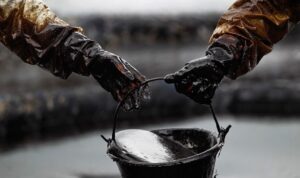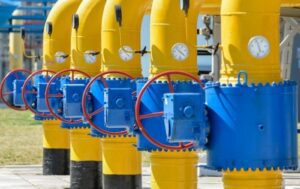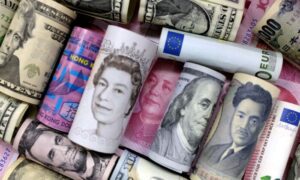
Agroholding KSG Agro harvested sunflower from 5 thousand hectares, which is 60% of the planned 8.4 thousand hectares, the harvesting of this crop is scheduled to be completed by October 12.
According to a press release from the agrarian group, the average sunflower yield was 18 centners per hectare.
“Of course, the current sunflower yield is lower than last year, but our weather pattern is completely different, since spring precipitation was very uneven even within the same farm. c/ha up to 29 c/ha, but on average 18 c/ha,” the holding company quotes the head of its crop production division, Dmitry Emelchenko.
According to him, the completion of the sunflower harvesting campaign depends on weather conditions and is scheduled, tentatively, for October 12.
KSG Agro also sows winter wheat on a total area of 4.2 thousand hectares and cares for winter rape crops on an area of 2.15 thousand hectares.
The vertically integrated holding KSG Agro is engaged in pig breeding, as well as the production, storage, processing and sale of grains and oilseeds. Its land bank is about 21 thousand hectares.
According to the agricultural holding, he is in the Top 5 pork producers in Ukraine.
In 2021, the holding increased its net profit by 16 times compared to 2020, to $20.27 million, revenue by 44%, to $30.75 million, while doubling EBITDA to $12.28 million.
The owner and chairman of the board of directors of KSG Agro is Sergey Kasyanov.

The composite index of the largest companies in the region Stoxx Europe 600 by 11:41 a.m. fell by 1.6% and amounted to 383.18 points.
The British stock index FTSE 100 falls by 1.67%, the German DAX – by 1.43%, the French CAC 40 – by 1.44%. Italian FTSE MIB loses 1.51%, Spanish IBEX 35 – 1.57%.
The market was supported the day before by the Bank of England’s decision to suspend the start of the previously announced government bond sale program and instead start buying government bonds amid a sharp increase in their yield. The spike in yields on UK public debt was triggered by the previously announced massive tax cut, which, according to the British authorities, will increase the budget deficit in the current fiscal year by more than 70 billion pounds.
At the same time, investors continue to worry about the consequences of rising borrowing costs amid persistently high inflation and the worsening energy crisis in the region, writes Trading Economics.
Belgian retailer Etablissementen Franz Colruyt N.V. led the decline among the components of the Stoxx Europe 600 index, losing 20.9%.
Meanwhile, preferred shares of luxury car maker Porsche AG rose moderately on Thursday, the first day of trading after Europe’s biggest IPO in a decade. Porsche shares, which trade under the ticker “P911”, are worth 84.84 euros, compared to the placement price of 82.50 euros.
Next Plc shares are down 8.3% in early trading on Thursday. The British chain of clothing stores in the first financial half of the year received revenue less than expected and worsened its full-year forecast.
Swedish Hennes & Mauritz AB (H&M) lost 2.4%. The owner of Europe’s second-largest clothing chain saw a sharp decline in net profit in the third financial quarter due to a massive write-down caused by the winding down of operations in Russia.

Oil analysts still expect oil prices to recover to almost $100 per barrel by the end of the year, despite the recent drop in quotations to January lows on concerns about global fuel demand.
The price of Brent will rise to just above $99 a barrel in the fourth quarter, according to a poll of analysts conducted by The Wall Street Journal. On Thursday, this variety is trading at around $88 per barrel.
North American oil WTI, according to the consensus forecast, will rise to about $95 per barrel from the current $80.9 per barrel.
Analysts generally believe that both brands will hold at these levels until mid-2023, and then rise slightly by the end of the year: Brent to $101 per barrel, WTI to $98 per barrel.
All interviewed experts are confident that the average cost of Brent in October-December will be at least $95 per barrel, except for Citi analysts – they adhere to the most pessimistic forecast and believe that North Sea oil will cost an average of $85 in the fourth quarter. The bank is also waiting for quotes to fall to $74 by the end of 2023, according to a WSJ survey.
Analysts believe that the expected reduction in OPEC + production will provide serious support to the oil market until the end of the year. In addition, the entry into force of European sanctions on Russian fuel could provoke a decrease in global supply by 1.5 million barrels per day, economists at Societe Generale said.

Shareholders of the National Insurance Company “Oranta” (Kyiv) re-elected the composition of the Supervisory Board at the meeting on September 20, the company reported in the information disclosure system of the National Securities and Stock Market Commission.
At the same time, Aleksey Bolkhovitinov, Artem Lisitsky, Aleksey Zosimov retained their membership in the Supervisory Board. Nikolai Safyannikov and Mikhail Ponomarenko dropped out of its membership, and Alexander Chorny (director of NS-Finance LLC) and Igor Gordienko (head of the board of IC INGO) were introduced.
As reported, Oranta collected UAH 1.182 billion in premiums in 2021, which is 24% more than in 2020. UAH 58.861 million (+13.8%) was transferred to reinsurance, of which UAH 39.470 million was transferred to residents, which is 37% more than a year earlier, UAH 19.391 million (-16%) to non-residents.
In the same year, the company made payments for UAH 442.930 million, which is 14.4% more than a year earlier. Payments from reinsurers amounted to UAH 21,660 thousand (2.5 times less).
As of December 31, 2021, the insurer’s reserves amounted to UAH 675.380 million (+11.9%), of which the part of reinsurers in insurance reserves amounted to UAH 64.501 million. Equity capital – UAH 322.485 million (+12.4%).
The company ended last year with a net profit of UAH 17.536 million, which is 2.6 times less than in 2020.
The authorized capital of the company has not changed and amounts to UAH 159 million.
JSC “NASK” Oranta “is the legal successor of “Ukrgosstrakh”, founded on November 25, 1921.
The main beneficiary of the LLC with 99.99% voting rights is Alexander Yaroslavsky.

The Gas Transmission System Operator of Ukraine, or GTSOU, has accepted a booking from Gazprom today to transport 42.4 million cubic meters of gas through the country against 42.4 mcm the previous gas day, data from GTSOU show.
Capacity was requested only through one of two entry points into Ukraine’s Gas Transmission System, the Sudzha metering station. A request was not accepted through the Sokhranivka metering station.
GTSOU has declared a force majeure about accepting gas for transit through Sokhranivka, claiming that it cannot control the Novopskov compressor station. Ukraine has also said that if gas continued to be fed from Russia to the Sokhranivka station, amounts would be reduced accordingly at the exit points from Ukraine’s gas transport system. The route through Sokhranivka had provided transit of more than 30 mcm of gas per day.
Gazprom believes there are no grounds for the force majeure or obstacles to continuing operations as before.
Electricity generated from wind power in Europe has dropped nearly 50% in the past two days, and the forecast for Thursday and Friday calls for practically calm weather, which requires utilizing other sources of energy.
Europe’s current temperatures are reaching all-time lows for the month of September, and could be the coldest for the past nine years at more than two degrees below last year’s figure. The forecast in Europe until the end of the month is light winds or calm weather.
Another cold spell has begun in Europe, and it should last at least a couple of days.
Electricity generated from wind power has dropped for the second consecutive day. Wind turbines generated 22.8% of the European Union’s energy balance on Monday, falling to 13.6% on Wednesday. Meantime, the figure is only 6.8% in Germany and 3.3% in the Netherlands, according to data from the WindEurope association. The average for September 2021 was 9.6%.
Spot prices for gas in Europe have risen sharply since Gazprom announced that Naftogaz Ukraine’s latest lawsuit could disrupt transit through Ukraine, adjusting to $2,005 per 1,000 cubic meters for the TTF day-ahead contract.
Prices in Asia are rising on the back of prices in Europe. The most expensive January futures on the JKM Platts index, which reflects spot market prices for gas delivered to Japan, South Korea, China and Taiwan, are $1,962 per 1,000 cubic meters.
The Nord Stream pipeline from Russia to Europe has been unable to restart as planned after maintenance, as oil leaks were found in Siemens turbines and this problem can only be fixed with factory repairs, Gazprom said. The Siemens turbines can only be repaired at a plant in Montreal, but Canada has imposed sanctions against the Russian gas giant.
Moreover, there were reports on Monday of a drop in gas pressure in two strings of Nord Stream 1 and in one string of Nord Stream 2 near the Danish island of Bornholm.
European liquefied natural gas (LNG) receiving terminals are operating at an average of 59% of capacity in September compared to 59% in August, data from Gas Infrastructure Europe indicate, and gas has been received from the EemsEnergy LNG floating receiving regasification terminal since September 16 in the Netherlands.
Europe is continuing to inject gas into underground gas storage (UGS) facilities, with the average level of reserves reaching the targeted 80% of capacity at the end of August. After reaching the target level, there has been some reduction in the injection rate.
Inventories in UGS facilities are currently at 88.17%, up just 0.2 percentage points from the last reporting date, according to Gas Infrastructure Europe data.
Gas inventories in UGS facilities have currently exceeded 80% in Belgium, the Czech Republic, Croatia, Denmark, France, Germany, Italy, the Netherlands, Poland, Portugal, and Spain.
Meanwhile, Austria, Bulgaria, Hungary, and Latvia are lagging, with Austria showing a clear trend toward reaching the target level of reserves by October 1, and Bulgaria and Hungary have also intensified injection, though could be several days late to the prized line.
The gas reserves at the Incukalns UGS facility in Latvia are the lowest in the EU at around 53%. Pumping is 50% below the European average despite this UGS facility being responsible for reserve gas supplies to Estonia, Latvia and Lithuania, as well as Finland.
Steady gas exports in the United States are reducing the amount of resources for injection into storage, which is supporting prices on the domestic market.
The current inventory level is around 71%, which is substantially below the reserves at UGS facilities in Europe, with the EU having topped this level a month-and-a-half ago, and even more so in Russia, which has over 90%.
Current reserves in the country’s UGS facilities are only 5% above the lowest figure in the past five years, and the figure fell in the summer injection season, though it has risen slightly in the past week, data from the U.S. Energy Department’s Energy Information Administration show. The lag behind the norm for the past five years is 10%.
The rate of injection increased during the last reporting week, with 2.9 billion cubic meters accumulated compared to 2.2 bcm on average over the previous reporting weeks. The end of using air conditioning and no heating demand thus far allow the industry to allocate more gas to storage.
The rate of injection into U.S. UGS facilities has improved somewhat after the suspension of exports through the Freeport LNG terminal owing to an accident.
Additionally, Cove Point terminal, with a capacity of 5.25 million tonnes per year, will stop for scheduled maintenance in September-October, with the volumes exported through the terminal also remaining on the domestic market.

The pound sterling again falls against the dollar due to renewed concerns about the British budget deficit amid announced tax cuts.
The pound by 9:05 a.m. fell 1% to $1.0782 compared to $1.0891 at the close of the previous session.
On the eve of the British currency rose after statements by the Bank of England about its intention to start buying long-term government bonds in an unlimited amount to stabilize the market, but the rise was short-lived.
Earlier this week, the pound hit a new all-time low against the dollar, and its fall since the beginning of the month could be a record since June 2016, when the British voted to leave the European Union.
The ICE-calculated index, which shows the dynamics of the US dollar against six currencies (the euro, Swiss franc, yen, Canadian dollar, pound sterling and the Swedish krona), rose by 0.85%, the broader WSJ Dollar – by 0.6%.
The euro/dollar pair is trading at $0.9668 compared to $0.9736 at the close of the session on Wednesday, the euro is losing about 0.7%.
The rate of the American currency against the yen increases by 0.4% and amounts to 144.64 yen compared to 144.12 yen the day before.
Meanwhile, the Chinese yuan is rising against the dollar for the first time in nine sessions. The yuan traded in mainland China rose to 7.1963/$1 from 7.2005/$1 at the close of the previous session.
The People’s Bank of China (PBOC, the country’s central bank) released a statement last night warning speculators that they would definitely lose money in the long run on betting on a weakening yuan and called on key market players to “protect the authority of the reference rate.”
The yuan on the mainland has fallen about 4% since the start of the month, and on Wednesday it hit a new low since 2008. Meanwhile, the offshore yuan traded in Hong Kong has fallen to its lowest level since the introduction of a separate trading system in 2010.